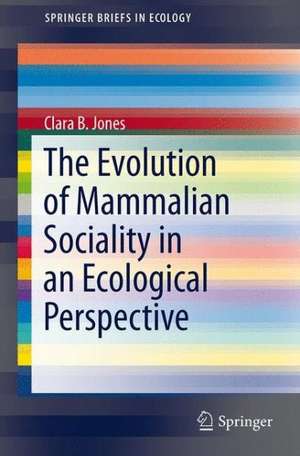The Evolution of Mammalian Sociality in an Ecological Perspective: SpringerBriefs in Ecology
Autor Clara B. Jonesen Limba Engleză Paperback – 30 ian 2014
Preț: 378.54 lei
Nou
Puncte Express: 568
Preț estimativ în valută:
72.45€ • 74.67$ • 61.17£
72.45€ • 74.67$ • 61.17£
Carte tipărită la comandă
Livrare economică 03-17 martie
Preluare comenzi: 021 569.72.76
Specificații
ISBN-13: 9783319039305
ISBN-10: 331903930X
Pagini: 123
Ilustrații: XI, 112 p. 11 illus., 3 illus. in color.
Dimensiuni: 155 x 235 x 17 mm
Greutate: 0.19 kg
Ediția:2014
Editura: Springer International Publishing
Colecția Springer
Seria SpringerBriefs in Ecology
Locul publicării:Cham, Switzerland
ISBN-10: 331903930X
Pagini: 123
Ilustrații: XI, 112 p. 11 illus., 3 illus. in color.
Dimensiuni: 155 x 235 x 17 mm
Greutate: 0.19 kg
Ediția:2014
Editura: Springer International Publishing
Colecția Springer
Seria SpringerBriefs in Ecology
Locul publicării:Cham, Switzerland
Public țintă
ResearchCuprins
1.Introduction: Definitions, Background.- 2. Competition For Limiting Resources, Hamilton’s Rule And Chesson’s R*.- 3. Flexible And Derived Varieties of Mammalian Social Organization: Promiscuity In Aggregations May Have Served As A Recent “Toolkit” Giving Rise To “Sexual Segregation”, Polygynous Social Structures, Monogamy, Polyandry And Leks Abstract.- 4. Multimale-Multifemale Groups And “Nested” Architectures: Collaboration Among Mammalian Males.- 5. Higher “Grades” Of Sociality In Class Mammalia: Primitive Eusociality.- 6. Ecological Models As Working Paradigms For “Unpacking” Positive And Negative Interactions Among Social Mammals.- 7. Mechanisms Underlying The Behavioral Ecology Of Group Formation.- 8. The Evolution Of Mammalian Sociality By Sexual Selection.- 9. Proximate Causation: Functional Traits And The Ubiquity Of Signaler To Receiver Interactions: From Biochemical To Whole Organism Levels Of Mammalian Social Organization.- 10. Synopsis.
Notă biografică
Clara B. Jones received her Ph.D. in Biopsychology from Cornell University. Since then she has served as Harvard University Postdoctoral Fellow in Population Genetics and as visiting faculty at Rutgers University in New Jersey as well as a visiting researcher at the Max Planck Institute for Behavioral Physiology in Bavaria. Dr. Jones has conducted fieldwork in Central and South America and has published over 100 articles and book chapters as well as four books.
Caracteristici
Situates the field of mammalian social biology beyond single species and populations Offers new notations for group and individual social competition among species Provides an ecological perspective of vertebrate sociality Includes supplementary material: sn.pub/extras




















